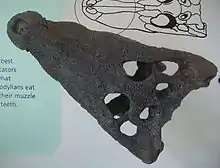| "Crocodylus" affinis Temporal range: Eocene, | |
|---|---|
 | |
| Scientific classification | |
| Domain: | Eukaryota |
| Kingdom: | Animalia |
| Phylum: | Chordata |
| Class: | Reptilia |
| Clade: | Archosauromorpha |
| Clade: | Archosauriformes |
| Order: | Crocodilia |
| Superfamily: | Crocodyloidea |
| Species: | †"Crocodylus" affinis Marsh, 1871 |
| Binomial name | |
| "Crocodylus" affinis | |
| Synonyms | |
| |
"Crocodylus" affinis is an extinct species of crocodyloid from the Eocene of Wyoming. Fossils were first described from the Bridger Formation by American paleontologist Othniel Charles Marsh in 1871. Marsh described the species, along with every other species of crocodyloid in the Bridger Formation, under the genus Crocodylus.[2] The known specimen of "Crocodylus" affinis is a skull found at Grizzly Buttes, Wyoming, measuring 13 inches in length on the upper surface.[3] Recent phylogenetic studies of crocodyloids show that "C." affinis is not a species of Crocodylus, but a genus has not yet been erected to include the species. Other Bridger species such as Crocodylus clavis and Brachyuranochampsa zangerli have been synonymized with "C." affinis.[4][5]

A 2018 tip dating study by Lee & Yates simultaneously using morphological, molecular (DNA sequencing), and stratigraphic (fossil age) data established the inter-relationships within Crocodilia,[6] which was expanded upon in 2021 by Hekkala et al. using paleogenomics by extracting DNA from the extinct Voay.[7]
The below cladogram shows the results of the latest studies, which placed "C." affinis outside of Crocodyloidea, as more basal than Longirostres (the combined group of crocodiles and gavialids).[6]
| Crocodylia |
| ||||||||||||||||||||||||||||||||||||||||||||||||||||||||||||||||||||||||
References
- ↑ Rio, Jonathan P.; Mannion, Philip D. (6 September 2021). "Phylogenetic analysis of a new morphological dataset elucidates the evolutionary history of Crocodylia and resolves the long-standing gharial problem". PeerJ. 9: e12094. doi:10.7717/peerj.12094. PMC 8428266. PMID 34567843.
- ↑ Mook, C.C. (1921). "Description of a skull of a Bridger crocodilian" (PDF). Bulletin of the American Museum of Natural History. 44 (11): 111–116.
- ↑ Marsh, O. C. (1871). Notice of some new fossil reptiles from the Cretaceous and Tertiary formations. American Journal of Science, s3-1(6), 447–459. doi:10.2475/ajs.s3-1.6.447
- ↑ de Buffrenil, V.; Buffetaut, E. (1981). "Skeletal growth lines in an Eocene crocodilian skull from Wyoming as an indicator of ontogenic age and paleoclimatic conditions". Journal of Vertebrate Paleontology. 1 (1): 57–65. doi:10.1080/02724634.1981.10011879.
- ↑ Brochu, C. A. (2000). "Phylogenetic relationships and divergence timing of Crocodylus based on morphology and the fossil record". Copeia. 2000 (3): 657–673. doi:10.1643/0045-8511(2000)000[0657:pradto]2.0.co;2.
- 1 2 Michael S. Y. Lee; Adam M. Yates (27 June 2018). "Tip-dating and homoplasy: reconciling the shallow molecular divergences of modern gharials with their long fossil". Proceedings of the Royal Society B. 285 (1881). doi:10.1098/rspb.2018.1071. PMC 6030529. PMID 30051855.
- ↑ Hekkala, E.; Gatesy, J.; Narechania, A.; Meredith, R.; Russello, M.; Aardema, M. L.; Jensen, E.; Montanari, S.; Brochu, C.; Norell, M.; Amato, G. (2021-04-27). "Paleogenomics illuminates the evolutionary history of the extinct Holocene "horned" crocodile of Madagascar, Voay robustus". Communications Biology. 4 (1): 505. doi:10.1038/s42003-021-02017-0. ISSN 2399-3642. PMC 8079395. PMID 33907305.


